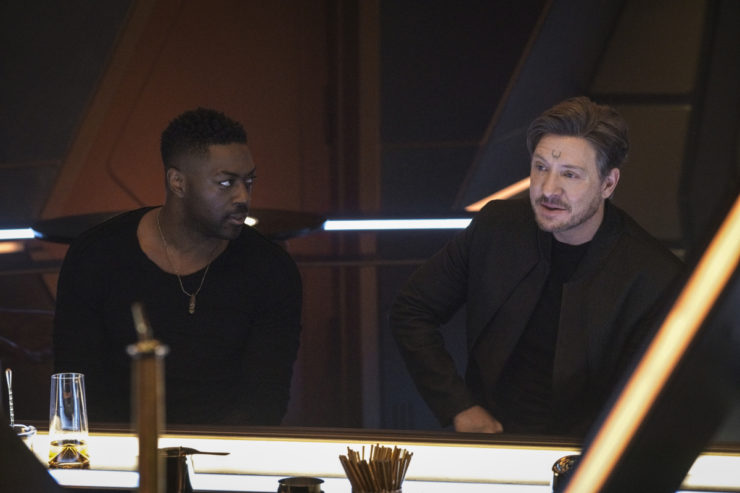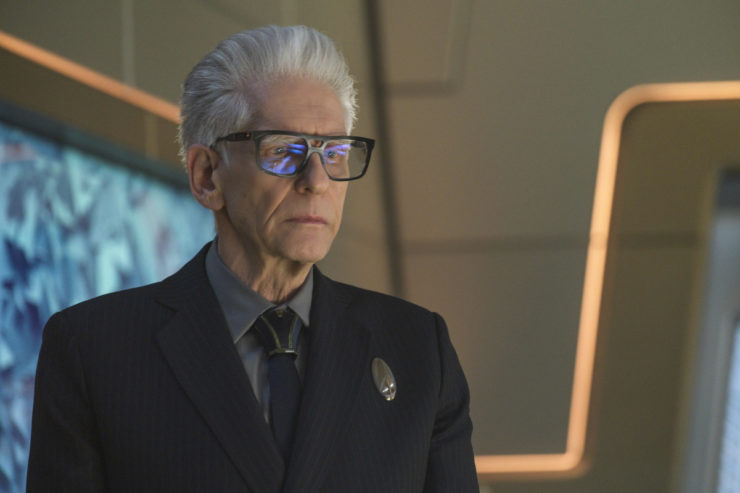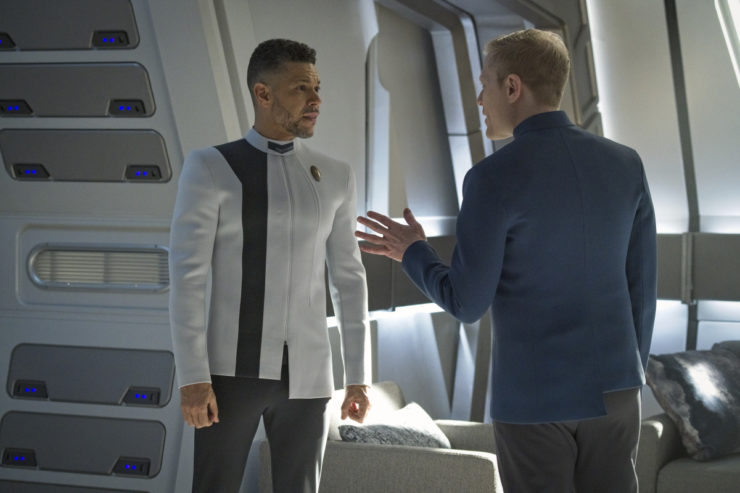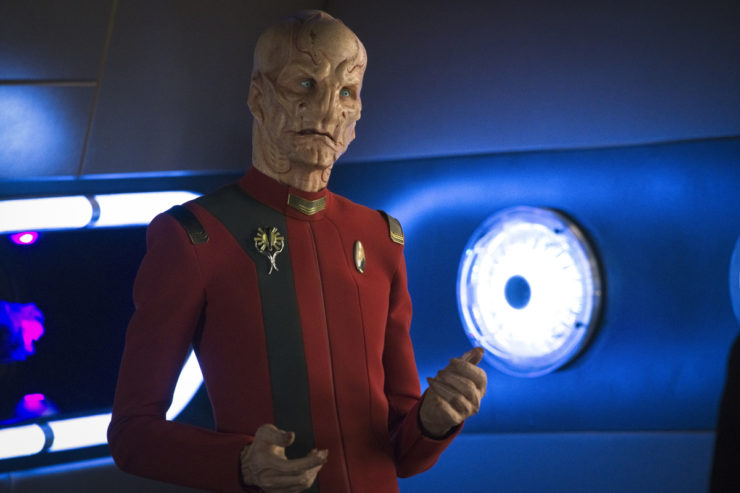One of the defining characteristics of the Paul Stamets character has been that he’s a spectacular snot, an arrogant jerk with poor people skills, whom people mostly only put up with because he’s so brilliant. Over the course of his experiences with the spore drive, the tragic death and difficult resurrection of his partner, and his sort-of adoption of Adira, he’s mellowed considerably over the three-plus seasons of the show.
So this week, we get a lovely reminder of what an asshole he used to be by bringing in a new one: Shawn Doyle as Ruon Tarka, a scientists from Risa who’s brought to Discovery to work with Stamets, Saru, and Jett Reno.
Yes, while neither Mary Wiseman nor Blu del Barrio are in this episode, Tig Notaro is, and she’s been elevated to opening-credits status, which is very much a good thing. Reno’s status has been unclear this season, but it looks like she’s still Discovery’s chief engineer.
Buy the Book


Sisters of the Forsaken Stars
Reno is involved in a project supervised by Saru and run by Stamets and Tarka. Two Starfleet ships (one of which, delightfully, is the U.S.S. Janeway) are examining the DMA, and suddenly it disappears, only to reappear a thousand light-years away.
This confirms that the DMA is not a natural phenomenon, but rather an artificial one. Up until now, the DMA has been treated like a hurricane or a rogue pulsar or some other disastrous occurrence that isn’t really in anybody’s control. Now that they know it’s a construct, the entire attitude of everyone involved changes. (It actually reminded me rather nastily of the events of September 2001. When the first plane crashed into the World Trade Center, it was a horrible accident. When the second plane crashed, suddenly it was an attack. That sea change is very much on display among the characters here.)
Tarka is trying to create a small-scale model of the DMA, but he lacks the power necessary to do it. Discovery does have the power—up to a point. They’re also in the middle of a rescue operation, as the DMA is now threatening an asteroid that used to belong to the Emerald Chain and which has a few thousand people on it. Discovery is leading the evac efforts (mainly because they got there first), and one of the reasons why Tarka can’t quite have full power for his simulation (as well as the containment field necessary to keep everyone safe) is because transporter power is needed for the evac.

Which raises the question, why do this there and then? Why not do it on another ship that isn’t in the middle of a rescue mission? Or wait until the rescue mission is over to do the test? Why the rush?
That plot hiccup aside, I love the fact that they subvert the usual clichés by having Saru cut off the power when he says he has to instead of letting it go too long because the hero’s got to get the thing done regardless of consequences. Reno’s comment afterward is epic: “That is the closest you’ve come to killing us all, and that’s really saying something.”
I also like that Saru has to play the role of the only grownup in the room, since if Stamets and Tarka were left to their own devices, they’d gleefully blow Discovery up if it meant another scrap of data.
He’s in charge because Burnham and Book are left to rescue the prisoners, who are the titular “Examples.” There are a half-dozen prisoners who are locked away behind a force field that stops communications and transporters. The prison staff is long gone, and the magistrate evinces no interest in lifting a finger to help the prisoners survive, so it’s left to Burnham and Book to mount a rescue. The rescue itself is fun—Sonequa Martin-Green and David Ajala have magnificent chemistry, and the brains-and-brawn teaming up they do here mixed in with lots of banter is likely how they behaved during Burnham’s year in the future before Discovery showed up between “That Hope is You” and “Far from Home.” (This is where I plug my dear friend and colleague Una McCormack’s excellent Discovery novel Wonderlands, which chronicles that year.)

The Examples are all imprisoned for life, even though the quality of their infractions vary wildly. These remnants of the Emerald Chain apparently believe in a one-size-fits-all style of justice. The prisoners are reluctant to go at first, thinking it’s some kind of trap that will make their lives worse, but Burnham is willing to grant them asylum. This entire plot is right out of a gaming scenario, with various traps that Book and Burnham have to navigate, but it’s exciting and entertaining, for all that I can sometimes hear the dice rolling. (For starters, Burnham totally had to make a saving throw versus charisma to convince the examples to come along with her…)
Only one prisoner doesn’t go, and he’s the only one for whom there’s an argument that he deserves to be imprisoned for life: played by Michael Grayeyes, he’s committed murder, and he would prefer to take his chances with the DMA—though he doesn’t reveal this until he knows for sure that the other prisoners are safe on board Discovery. His last act is to confess to the Discovery crew what he did. It’s a strong performance by Grayeyes, but what I like in particular is the effect it has on Book. He can’t bear the notion of leaving anyone behind to be killed by the same thing that wiped out his homeworld. But Burnham can’t force him to leave, either.
My favorite scenes in this episode, though, are those involving Culber. He has done an amazing job as ship’s counselor, but that leaves the question of who counsels the counselor. That’s left to the delightfully blunt Kovich, a welcome return by David Cronenberg. Remembering how direct Kovich was with Georgiou, Culber asks for similar directness in helping him out. Kovich reminds Culber that he’s suffering tremendous trauma himself, having come back from the dead and all.
We also see Culber and Stamets together, which has been rare this season, as Stamets both bitches to his partner and also expresses concern for his mental health. It’s the first time we’ve seen Culber really be vulnerable in a while, and Wilson Cruz plays it beautifully, showing the broken person behind the helpful façade that he presents to his patients. I hope we get more of this—I know that both of them have different roles on the ship, but Stamets and Culber are such a great couple, the best and sweetest of the three couples in the cast, and we need more of them. (Nothing against Burnham and Book, who are a delight, or Adira and Gray, who are fabulous, but we’ve gotten lots of those four and I want more of Stamets and Culber, dagnabbit. The teeth-brushing scene in “Choose Your Pain” remains one of the loveliest and most romantic scenes in Trek’s five-plus decades, and we need more of that, please and thank you.

We also get several reminders of the greater Trek universe, starting with Tarka’s homeworld. One of the fun things about him being from Risa is that it’s a planet of hedonists (as we saw way back in DS9’s “Let He Who is Without Sin…”), and so he’s kind of a weirdo on his own world, which is likely why he’s such a dick.
Once it’s clear that the DMA is artificial, there is discussion as to where it might have come from. Vance specifically cites the Metrons (who pit Kirk and a Gorn against each other in the original series’ “Arena”), the Nacene (who yanked a mess of ships, including both Voyager and Equinox, into the Delta Quadrant), remnants of the Iconians (introduced in TNG’s “Contagion,” and who were established as possibly still being around in the “Gateways” novel crossover, so that’s a nice touch), and the Q-Continuum (introduced in TNG’s “Encounter at Farpoint,” and to be seen again soon in the second season of Picard), though Vance says that there’s been no contact with the Q in six hundred years (and one wonders if that’s some manner of preview of that upcoming Picard season or just the Discovery producers washing their hands of using the Q entirely…).
Plus, in a really nice touch, Stamets and Reno are looking at a three-dimensional star map, which is full of familiar names: Denobula, Ni’Var, Tellar, Andoria, Deneva, Wolf 359, Calder, Barradas, Tagus, Qualor, Argelius, Nelvana, etc. Oh, and Earth. In an even nicer touch, we see a bunch of starbases. One is Starbase 10, established in the original series’ “The Deadly Years” as being near Romulan space, and on the map it’s proximate to Calder, Nelvana, and Barradas, all worlds established as near Romulan territory; another is Starbase 1, near Earth. Although, I’m greatly disappointed that neither Tarka nor Stamets mention the Bajoran wormhole when discussing artificial wormholes…
Part of me is disappointed that the DMA is artificial, just because it’s yet another big bad threatening the galaxy, and we’ve been down that road way too much in the Secret Hideout era of Trek. On the other hand, we don’t know everything yet, and there are still lots of possibilities as to the true purpose behind it. After all, the Burn wasn’t an attack or a natural phenomenon, but a child’s temper tantrum. So I’m waiting and seeing, and hoping that it’s something a bit more interesting than a super-weapon…
Keith R.A. DeCandido is one of the many author guests at DisCon III, the 79th World Science Fiction Convention, this weekend at the Omni Shoreham Hotel in Washington, D.C. Click here for his full schedule.










